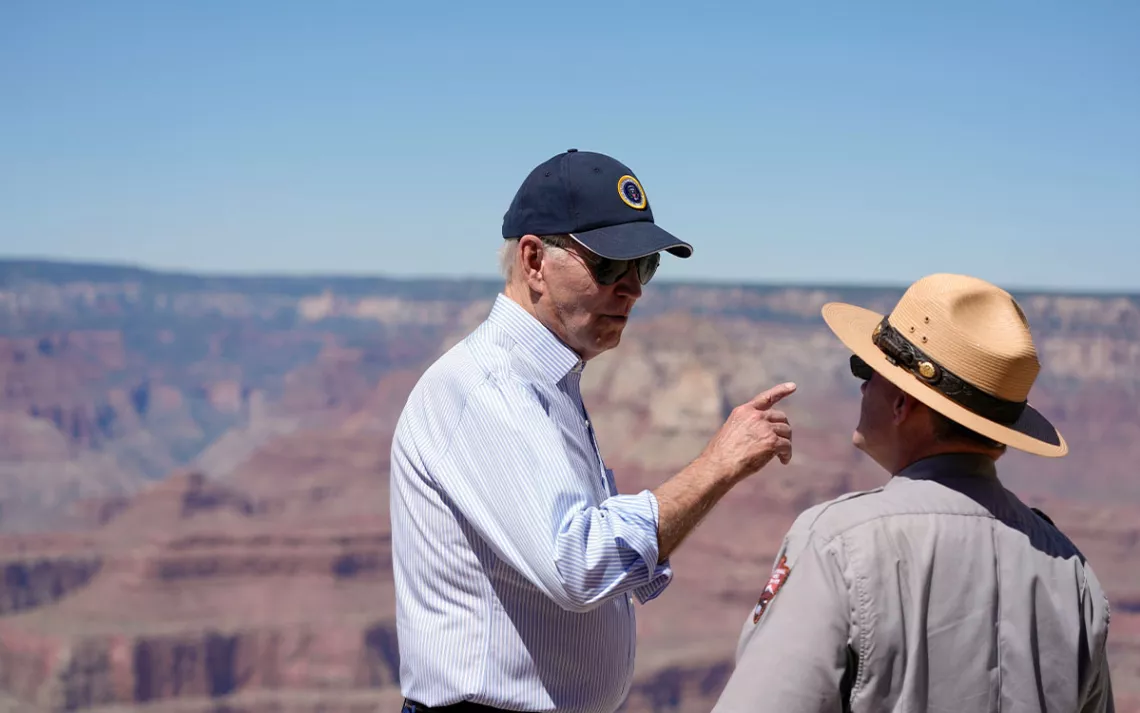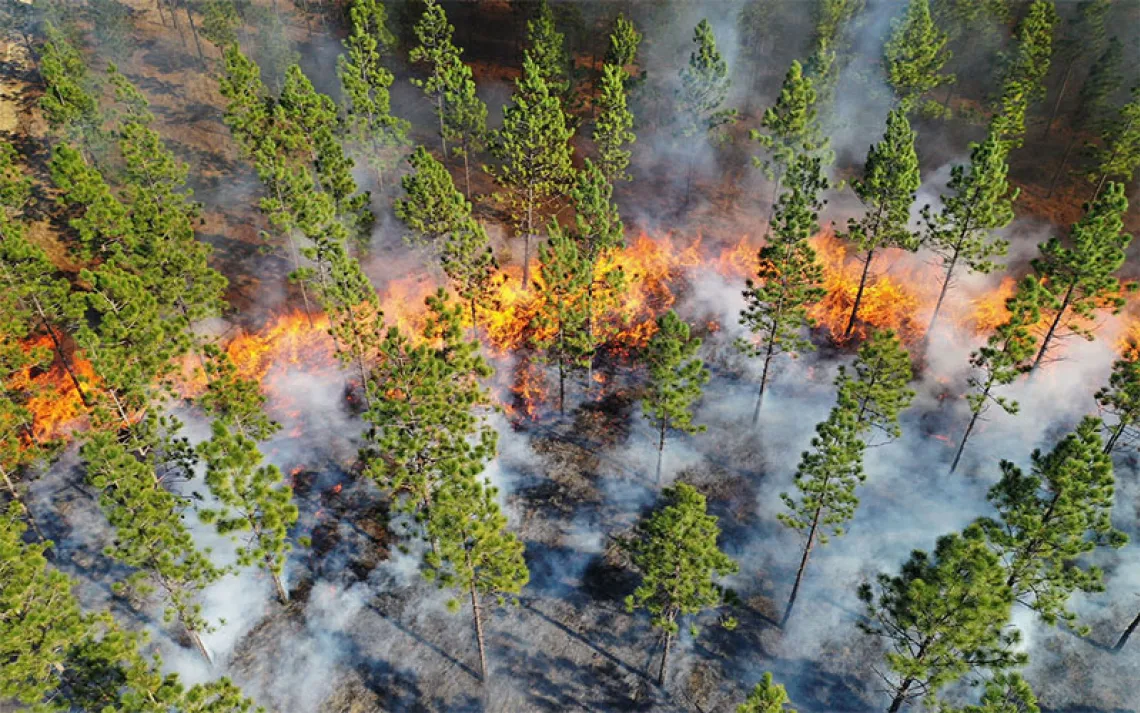Environmentalists Have a Wish List for the Lame Duck Session
President Biden will have an impressive conservation legacy. He could go even further if he did these things.

President Joe Biden talks with Ed Keable, superintendent of Grand Canyon National Park. | Photo by Alex Brandon/AP
Americans who care about public lands conservation, wildlife protection, and climate action are bracing for a grim future. President-elect Donald Trump has boasted about gutting key climate programs to appease fossil fuel interests. And right-wing lawmakers, who will control both houses of Congress, are sharpening their axes to cut funding for endangered species protections, aiming to rescind laws meant to curb greenhouse gas emissions, and even daydreaming about selling off public lands.
Environmental groups will be an essential check on the next administration. Leaders at groups like the Center for Biological Diversity, the Sierra Club, and Earthjustice are already preparing legal strategies to combat Trump’s policies, activating their grassroots networks and seeking legislators who will advocate for environmental protections.
But there’s another antidote to the next administration’s antics—and that’s President Biden. Congress is in session for four more weeks, and the president has committed to working up until January 20. Environmental organizations have a list of suggestions that they’re urging the president to consider, and he and his team seem eager to continue at least some of their environmental work. The challenge for environmental groups and the White House now is to merge their ambitions.
“While the United States federal government of Donald Trump may put climate action on the back burner, the work to contain climate change is going to continue in the United States with commitment and passion and belief,” John Podesta, President Biden’s senior climate adviser, said at the United Nations climate summit in Azerbaijan last week.
More national monuments
Conservation groups' biggest public lands priority is getting the president to designate more national monuments. These areas protect some of the country's most treasured public lands. Outdoor coalitions have prepared a list of outstanding areas they think are ripe for monument status. Establishing them should be an easy lift for the president—these lands are already public, there’s local support, and all that’s needed is his signature.
Last month, at the United Nations biodiversity conference in Colombia, Native American tribes called on President Biden to create three national monuments in California. These areas include the Kw’tsán National Monument in Southern California, the Chuckwalla National Monument near Joshua Tree National Park, and the Sáttítla National Monument close to the Oregon border. While some Republican allies have asked President Trump to downsize national monuments, that would likely be an uphill battle.
“The Antiquities Act is a one-way street,” said Athan Manuel, the public lands director at the Sierra Club. “It just provides the apparatus to name a new monument, but it doesn't have any provisions for undoing monuments. So we are pushing for [President Biden] to try and name as many monuments as possible.”
Fill judicial vacancies
Environmentalists are also calling on President Biden to nominate federal judges who have a strong grasp of environmental law. In recent years, federal judges have shaped American policy perhaps even more so than legislators. The most recent high-profile environmental decision ended the Chevron Doctrine, a 40-year-old legal theory that judges have cited when deferring to federal agencies to interpret ambiguous statutes.
In the wake of the 2024 election, Senate leaders and the White House have hinted at ramping up nominations. Filling the 46 open judgeships, split between the US district courts and the courts of appeals, will likely mean the difference between protecting an endangered species and letting developers run roughshod over the National Environmental Policy Act and the Endangered Species Act. “Basically, any environmental rule of any magnitude is challenged in the courts,” Lisa Heinzerling, a law professor at Georgetown University and a senior adviser to former President Barack Obama’s Environmental Protection Agency, told NPR this past summer. “The courts have the final word.”
New rules
At the administrative level, conservation groups hope two federal agencies will finalize long-overdue decisions before the next president takes office. The US Fish and Wildlife Department has been mulling over federal protections for grizzly bears for almost two years. The agency was supposed to release a decision back in the summer but punted to January at the last minute. Conservation groups want the agency to keep bears listed throughout their range, given that there are so few bears and limited connectivity between populations. Keeping the bears listed would make it harder for a future administration to delist them in the immediate future, said Bradley Williams, the deputy legislative director for the Sierra Club's Wildlife and Lands Protection campaign.
Meanwhile, the Department of Energy is updating the studies it uses to assess pending and new LNG export applications. The agency announced a pause on new LNG exports in January while it conducted its analysis. Now climate advocates are hoping the administration will reject six pending requests to build new facilities, especially Venture Global's Calcasieu Pass 2 facility on the Gulf Coast. If completed, it would be the region’s largest LNG facility, pumping out the annual emissions of 51 coal-fired power plants.

Make every day an Earth Day
Get articles like this one sent directly to your inbox.
With this action you affirm you want to receive Sierra Club communications and may vote on policy designated by the Sierra Club Board.
The challenge for environmental groups and the White House now is to merge their ambitions.
Action in Congress
There is still work to be done by Congress. Lawmakers have until December 20 to pass a spending bill to fund the federal government. This package could be an opportunity to squeeze in funding for land-management agencies, like the National Park Service, or pass last-minute environmental legislative packages, such as the EXPLORE Act, which expands access to the outdoors. House lawmakers passed a version of the bill in the summer. Now it only needs to get through the Senate to reach the president's desk.
Smaller lands packages, like the effort to preserve Black Wall Street in Tulsa, Oklahoma, or the Owyhee Canyonlands in Oregon, could also be included in the yet-to-be-passed National Defense Authorization Act. That bill, which sets annual funding for the armed forces, has typically had broad support and has been reauthorized every year for the past six decades.
“Specifically, around public lands packages, I think there's a lot of interest to get something done in a bipartisan way,” Emily Douce, the deputy vice president for government affairs at the National Parks Conservation Association, said. “It's not going to be as robust as we had hoped, but I think it will be meaningful to get some of these bills … done.”
Keep conservation front and center
The Biden administration has ushered in some of the most significant conservation wins in history, and Republicans will have a tougher time than they might expect in their attempts to whittle away at President Biden’s accomplishments. The Bureau of Land Management made conservation a dedicated use of public land, on par with oil and gas leasing, and reaffirmed protections across 28 million acres of land in Alaska. The Department of the Interior created 13 million acres of protected areas in the National Petroleum Reserve. And more recently, the Biden administration carved out the smallest acreage of land legally possible for a mandated oil and gas sale in the Arctic National Wildlife Refuge.
The president has designated five national monuments and expanded two existing monuments, totaling over a million and half acres. Biden created the America the Beautiful initiative, which aims to protect 30 percent of the nation’s lands and waters by 2030, and his administration incorporated Indigenous traditional ecological knowledge into federal lands decisions.
The consensus among environmentalists is that public lands and wildlife remain popular. They hope that by continuing to raise awareness about these issues, they can influence President Biden, Congress, and even the Trump administration to reconsider completely abandoning conservation efforts.
“No one voted for any of the stuff that Trump's going to try and do on public lands,” Manuel, from the Sierra Club, said. “We will be able to call on that wellspring of popular support for protecting special places and leverage that with folks.… I still think [Republicans] probably don't have the votes to do all the things President Trump wants to do. And that's the ray of hope.”
 The Magazine of The Sierra Club
The Magazine of The Sierra Club



